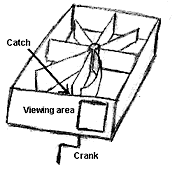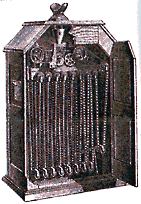


 The Kineograph was invented officially in 1868. It is also known as a flipbook, and consists of drawings or photographs in sequential stages of movement bound as a book. To view, the book was flipped through rapidly with the thumb. These were simple but effective, and were the first devices to present animation in a linear, rather than circular, sequence. Thomas Edison took the idea and in 1895 developed the Mutoscope, which was a sort of mechanized version of the flipbook. These were popular amusements well into the first half of the 20th century.
The Kineograph was invented officially in 1868. It is also known as a flipbook, and consists of drawings or photographs in sequential stages of movement bound as a book. To view, the book was flipped through rapidly with the thumb. These were simple but effective, and were the first devices to present animation in a linear, rather than circular, sequence. Thomas Edison took the idea and in 1895 developed the Mutoscope, which was a sort of mechanized version of the flipbook. These were popular amusements well into the first half of the 20th century.
The Kineograph is simple but rewarding to construct. Start with a small blank tablet of fairly stiff paper. On each page, draw one image. The movement of each drawing should lead into the next. Keep in mind that the images will move by at a rate of many per second, so the movements should be gradual. Once you are happy with your drawings, rapidly flip through the pages. The little drawings should spring to life.
 The Mutoscope is based on the same principle, but the images are drawn on individual cards and are flipped mechanically. This can be reproduced fairly simply, but the sequence won't be as long. Shown in the drawing is a basic layout. The images are on small, tabbed cards stuck evenly around a cork. The cork is impaled on to a thin bent metal rod that serves as a crank. The whole thing is set in a box with a small window cut into it and a protruding tab to catch the images, causing the "flip" action. The box should be just large and deep enough to accommodate the images.
The Mutoscope is based on the same principle, but the images are drawn on individual cards and are flipped mechanically. This can be reproduced fairly simply, but the sequence won't be as long. Shown in the drawing is a basic layout. The images are on small, tabbed cards stuck evenly around a cork. The cork is impaled on to a thin bent metal rod that serves as a crank. The whole thing is set in a box with a small window cut into it and a protruding tab to catch the images, causing the "flip" action. The box should be just large and deep enough to accommodate the images.
 The Praxinoscope was the pinnacle of design among the animation toys. It was very much like the zoetrope; the images were drawn or painted on a strip of paper that was placed in a rotating drum. There were no slits - the image was viewed reflected in a series of mirrors fixed at the axis of the wheel. Because it used mirrors instead of rotating slits, the image produced by the Praxinoscope was brighter and clearer than that of the zoetrope. Also, it could be projected. Reyneaud used this to his advantage, and opened the Théâtre Optique, presenting the some of the earliest and most commercially successful projected moving images.
The Praxinoscope was the pinnacle of design among the animation toys. It was very much like the zoetrope; the images were drawn or painted on a strip of paper that was placed in a rotating drum. There were no slits - the image was viewed reflected in a series of mirrors fixed at the axis of the wheel. Because it used mirrors instead of rotating slits, the image produced by the Praxinoscope was brighter and clearer than that of the zoetrope. Also, it could be projected. Reyneaud used this to his advantage, and opened the Théâtre Optique, presenting the some of the earliest and most commercially successful projected moving images.
It is possible to build one of these, but somewhat difficult. The basic design is the same as the zoetrope, except that there are no slits in the drum, and there is a circle of mirrors in the center, one for each image. The mirrors are fixed so that they rotate with the drum.
At the same time these animation devices were being developed, photography had been born and growing in leaps and bounds. In 1877, the governor of California had been involved in a bet that, as a horse ran, all four of its legs left the ground. To prove his theory correct, he hired Edward Muybridge, an itinerant photographer. Muybridge set up a series of cameras, 12 of them originally, and connected them to wires. The wires were broken in turn by a horse as it ran by, and the resulting images recorded true stages of motion for the first time. The governor won his bet, and Muybridge continued to photograph series of movements of all sorts of animals, as well as people. Many of his studies were turned into zoetrope strips. He developed the Zoopraxiscope, based on the projecting Phenakistiscope, to project his series. It produced the first projected images of true motion.
 To the left are frames from Fred Ott's Sneeze, shot at the Edison studios. It became the world's first copyrighted film on Jan. 7, 1894.
To the left are frames from Fred Ott's Sneeze, shot at the Edison studios. It became the world's first copyrighted film on Jan. 7, 1894.  Animation toys would remain pretty much that until George Eastman invented celluloid film in 1884. Thomas Edison and his staff thenThe Kinetoscope developed the Kinetograph, a large, bulky camera, and the Kinetoscope, a "peep hole" type machine for viewing the filmstrips. These were successful entertainment, but could only be viewed by one person at a time. (An assistant of Edison, William Dickson, developed in1889 the Kinetophonograph, which produced the earliest by far projected image with sound. Edison chose not to pursue the invention, supposedly due to poor quality, and it would be almost 40 years before a commercially viable sound motion picture system would be developed.) In 1895 the Lumière brothers invented the first practical portable cinema camera, and the golden age of animation toys was history.
Animation toys would remain pretty much that until George Eastman invented celluloid film in 1884. Thomas Edison and his staff thenThe Kinetoscope developed the Kinetograph, a large, bulky camera, and the Kinetoscope, a "peep hole" type machine for viewing the filmstrips. These were successful entertainment, but could only be viewed by one person at a time. (An assistant of Edison, William Dickson, developed in1889 the Kinetophonograph, which produced the earliest by far projected image with sound. Edison chose not to pursue the invention, supposedly due to poor quality, and it would be almost 40 years before a commercially viable sound motion picture system would be developed.) In 1895 the Lumière brothers invented the first practical portable cinema camera, and the golden age of animation toys was history.

This article was printed from the Bizarre Labs website at bizarrelabs.com